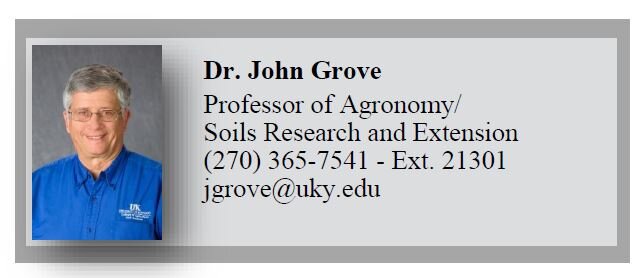Some Early Thoughts On This Fall’s Soil Fertility Management
SOIL TESTING for the next crop is important this fall. The summer season’s drought, after spring wetness (with compaction issues), is causing lower, more variable, corn and soybean yields. Lower grain yield means lower nutrient removal, but this is not perfectly predictable from a yield monitor. Drought affected grain is usually nutrient rich compared to rainy season grain. More corn acres will be harvested for silage rather than grain and nutrient removal is greater with silage. Soil test ‘problem’ fields/areas identified earlier this season. If you don’t do your own soil sampling, you might want to book sampling services early – this year there are more questions that need samples to inform decision-making.
SOIL ACIDITY hurts root activity – a bigger problem in droughty seasons. Once soil test results are in, take a close look at soil pH. If needed, and if weather permits, lime should always be applied in the fall. Good quality lime takes time to dissolve and cause the carbonates to neutralize soil acidity.
DECIDING WHETHER TO APPLY fall nutrients, especially for corn and soybean, is more difficult this year. The decision generally depends on the target crop (wheat/forages vs. corn/soy); economics/value of fertilizer, time, and equipment; and the soil test value (low values mean higher recommended rates – better nutrient use efficiency when needy soils are fertilized to better match crop demand = spring for summer crops like corn and soybean). Fertilizer prices are lower (except for potash) now, but still high relative to prior years.
WHEAT follows corn in many areas. This year, most wheat will not need fall nitrogen (N). Lower corn yield causes less N removal. Tissue N will be higher in corn residues, giving greater N availability as residues decompose. Many grain producers have fields in forage production. Likely under fertilized this year, these crops/fields may really need some fall fertility to improve stand health, winterhardiness, and both forage quality and stand competitiveness with weeds next spring.
A WINTER COVER CROP can contribute. In addition to protecting against soil erosion (especially with less full-season soy residues this year), cover crops cause greater nutrient retention against fall-winter losses. One ton of rye dry matter (good stand, 12 to 18 inches tall) contains about 35 lb N, 45 lb K2O, and 10 lb P2O5. These nutrients won’t all be immediately available with rye termination next spring, but $32(N) + $33(K2O) + $7(P2O5) = $72 worth of nutrients, considering the most recent aver-age retail fertilizer price levels (https://www.dtnpf.com/agriculture/web/ag/crops/article/2022/08/02/summer-slump-retail-fertilizer), are retained.
FALL NUTRIENT SOURCE DECISIONS might also be difficult. This fall, the need for fertilizer N will be significantly lower. Fall application of N, regardless the nutrient source, will be less economical and losses are more likely, given likely greater fall background soil N levels. Nutrient sources containing N and other important nutrients (DAP, 18-46-0; MAP, 11-52-0; poultry litter) are usually priced considering their N content, making them less desirable for fall application to wheat, corn, and soy acres this fall. DAP, 18-46-0, is a popular fertilizer P source and the most recent DTN survey average retail price (the URL just above) was $1005/ton. Urea, 46-0-0, was $836/ton ($0.909/lb N). This means that the 360 lb N in one ton of DAP was worth about $327, and the phosphate value was $678/ton DAP ($0.737/lb P2O5). About a third of the price of DAP is in the value of N it contains – N that is less likely to be needed this fall. You might ask your fertilizer retailer to bring in triple super phosphate (0-46-0) so that you can meet your fall phosphate needs without losing money on unnecessary N.
FERTILIZER PLACEMENT (banding) improves fertilizer P and K use efficiency, relative to broadcast fertilizer. AGR 1 (http://www2.ca.uky.edu/agcomm/pubs/agr/agr1/agr1.pdf) indicates that in spring, if soil test P and/or K are very low or low, one-third to one-half the recommended rates of P2O5 and/or K2O for corn can be used if it is banded 2 to 4 inches from the row. Relevant research for Kentucky soils is not available, but I’d estimate that precision (GPS guided) banding fall applied P and K would similarly improve their use efficiency relative to fall broadcast P and K. Precision fall banding would likely be superior to spring broadcasting, though not as good as spring banding, as long as corn is planted 2 to 4 inches from the banded P and K. Precision fall placement anticipates precision spring planting.

